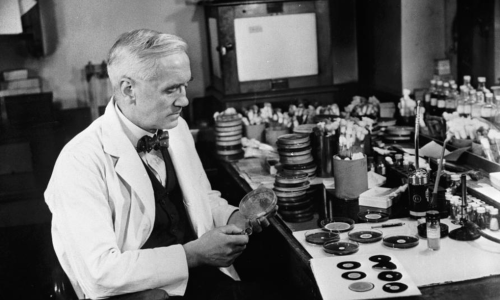- People
- Research
- Graduate
-
Undergraduate
- Prospective & Transfer Students
- General Chemistry Options
- Policies
- Tutors
- Pre-Health
- Undergraduate Advisors
-
Chemistry Major
- Process for Declaring a Major, Minor, DMP, or ACS Certification
- B.A. in Chemistry
- B.S. Chemistry
- B.S. Specialization in Biochemistry
- B.S. Specialization in Chemical Education
- B.S. Specialization in Chemical Physics
- B.S. Specialization in Environmental Chemistry
- B.S. Specialization in Materials Science
- B.A./M.S. or B.S./M.S. in Chemistry ("3+1" Degree Option)
- Undergraduate Research
- Distinguished Majors Program
- Minor
- Forms
- Study Abroad
- Undergraduate FAQs
- Undergraduate Resources
- Safety
- Seminars
- Newsletter
Elizabeth K. Johnson, UVA ChemSciComm
When Dr. Alexander Fleming came back from vacation to find that one of his petri dishes of staphylococcus bacteria (more commonly known as staph infection) had an unknown type of mold growing in it, he thought his experiment had failed. However, after closer inspection, he noticed that the staph bacteria weren’t growing around this mysterious mold, and Fleming had accidentally discovered the first antibiotic, which he later decided to name penicillin.
Fleming’s initial discovery was in 1928 but it would be another 15 years before the mold could be employed on wide-spread scale as medicine. Fleming found purifying the mold to be extremely difficult, and even after recruiting the help of several world-renowned chemists, he was forced to give up on the project after several years of hard work.
Nine years later in 1937, scientists Howard Florey and Ernst Chain took a newfound interest in Fleming’s mystery mold and decided to again attempt its purification to create a medicine suitable for human ingestion. It took three years for the pair to produce pure penicillin, but the process was so inefficient that it couldn’t be utilized on an industrial scale. Gallons of mold broth would produce only enough penicillin for a single dose.
In 1941, Florey moved the nascent penicillin production process to Peoria, Illinois in hopes of utilizing the Department of Agriculture’s expertise on fermentation. They found that when a by-product of corn starch was added to the mold broth, the yield of penicillin exponentially increased. It was assumed that the high concentration of sugars, amino acids, and nitrogen in the corn product was the reason for the increase in yield. After an extensive hunt for strains of mold that had higher concentrations of penicillin, Mary Hunt found a rotting cantaloupe at a store. The mold in this melon produced six times more penicillin than Dr. Fleming’s original accidental discovery, ultimately enabling the levels of production we have today.
Penicillin is estimated to be responsible for saving over 500 million lives since its discovery, becoming the first successful and scalable way to effectively treat a bacterial infection. In equally important lesson is the appreciation of serendipity in scientific discovery – paying attention to experimental ‘accidents’ can often be important to innovation!
Sources:
https://www.path.ox.ac.uk/centenary/our-history/
https://www.sciencemuseum.org.uk/objects-and-stories/how-was-penicillin-developed
